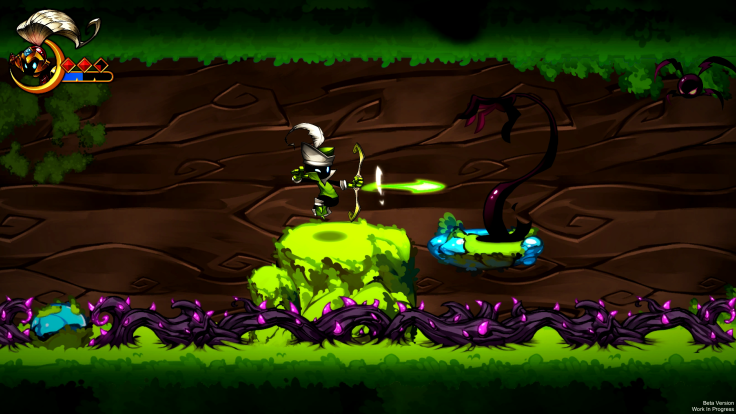Pankapu the Dreamkeeper is a 2D illustrated platformer from French indie game studio Too Kind about a child plagued with bad dreams whose father tells him a story to make him feel better. You get to play out the story as brave Pankapu, the Dreamkeeper who must rout out the forces of Nightmare from Dreamworld.
The game’s art is cartoony and bright, reminiscent of the best Sega Genesis titles, with a polished and hand-illustrated look. Pankapu is an adorable dollop of energy with bright blue eyes who switches costumes sometimes, which is super cute. His friends and foes are drawn with just as much care and attention as the beautiful shifting landscapes themselves. The art style is very consistent, with lots of whirls and swirls. Everything from the enemy blobs to the feather on Pankapu’s hat is lovingly detailed. The art style alone makes combat and moving through the levels a pleasure.
You can revisit the awesome character design and intricate myths of the world by hitting Escape to view the menu, which you maneuver through with Page Up and Page Down (it took me an embarrassing amount of time to realize this). The “mytholith” has lore and art for locations, enemies, characters and others, while the “memolith” pages gather all the memory fragments you’ve unlocked from the real world.
Pankapu is telling two stories, but you spend most of your time in Pankapu’s story, protecting your friends in the Dreamworld. Your friends include a companion spider buddy who knows everything about the Dreamworld and a sweet being named Ohiti, whose friends the Mudjin are embodiments of hope and light. Other characters, such as the mysterious Vaya, appear more infrequently but are wreathed in lore which you can check in the mytholith.
You spend a lot of time on what are basically fetch quests to give you more power, seek out special items that unlock further areas of the environment and so on. The details of each quest feel a little pointless; while the framing story and the Dreamworld are both super interesting, the quests themselves feel flimsy, just an excuse to go through the levels. Considering the framing story’s mystery and promise, the constant “Ohiti escapes, Ohiti is kidnapped, Ohiti escapes and is kidnapped again” feels contrived.
Basic gameplay is standard for a platformer. You progress linearly through levels by jumping from platform to platform, maneuvering through tough territory, and warding off enemies. There are some hidden areas, but by and large you’re going from point A to point B with no doubling back. You proceed from level to level on a larger world map in just as linear a fashion.
Combat is based around several different “Aegis” job classes. Each “Aegis” has its own special abilities and adorable costume, and you have to adjust your playstyle with each one. For example, Ardor gives you extra damage-dealing and a great double-jump, but eliminates the shield you possess in Bravery, making you play more cautiously.
You can also find and equip different “Nebulas” no matter what Aegis you’re playing with, which add different flairs to your attacks. The names are a little confusing, but in keeping with the whimsy of Pankapu . They make Pankapu feel like an entirely new character.
There are plenty of twists on the platform concept: there are platforms that rotate, platforms that sink, platforms that are invisible until you approach them, platforms that pop a second after you land on them, and so on. Each level manages to mix up the combination of platforms and enemies enough to provide a challenge - challenges that can sometimes prove maddening. But Pankapu is very friendly to player death, and you simply restart with three hearts of health and a full ability meter from your last Checkpoint.
There are plenty of collectibles for the discerning player to keep track of, including fragments that increase your health bar, the Mudjin and more. Seeking these collectibles out adds an additional level of challenge, as does the addition of a “Time Trial” mode. Boss fights are reasonably tough, though it’s not exactly a puzzle to figure out how to defeat them.
Ultimately, Pankapu is an accessible and beautiful game that should appeal not only to younger audiences, but to adults with a sense of whimsy who want a busy game that promises to keep them occupied. Between challenging level design, tracking down all the collectibles and memory fragments, and fiddling with the Aegis and Nebulas, Pankapu players can expect to enjoy their time in the Dreamworld -- and be intrigued by the mystery of what surrounds it.
Pankapu comes from a successful Kickstarter with the Square Enix Collective, “a curated platform that enables creators to post ideas, and gamers to judge whether those ideas should become reality or not.... Essentially, we’re trying to help small teams build awareness of their ideas, and ultimately self-publish – while retaining IP and full creative control.”
For more information, check out Pankapu ’s Steam page here.


















